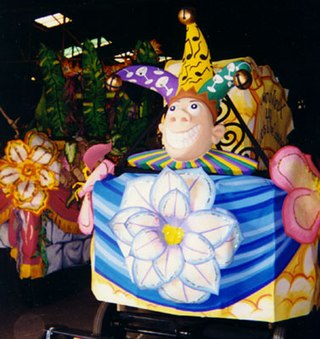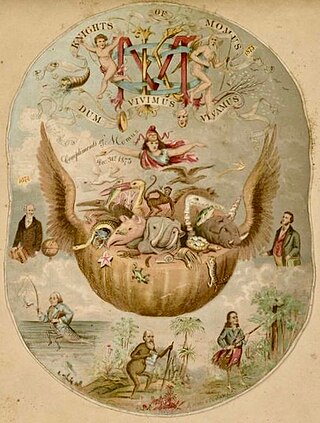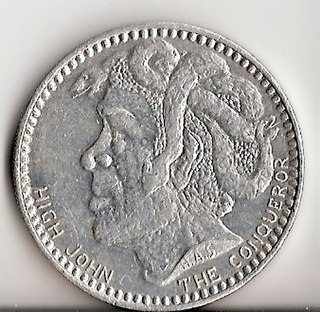Related Research Articles

The Mistick Krewe of Comus (MKC), founded in 1856, is the oldest extant New Orleans, Louisiana Carnival Krewe, the longest to continually parade with few interruptions from 1856 to 1991, and continues to hold a tableau ball for its members and guests, to date. Initially its public facade was The Pickwick Club.

The Rex Organization, commonly referred to simply as Rex, is a New Orleans Carnival krewe which stages one of the city's most celebrated parades on Mardi Gras Day. Rex is Latin for 'king', and Rex reigns as "The King of Carnival".

The holiday of Mardi Gras is celebrated in southern Louisiana, including the city of New Orleans. Celebrations are concentrated for about two weeks before and through Shrove Tuesday, the day before Ash Wednesday. Mardi Gras is French for Fat Tuesday, the season is known as Carnival and begins on 12th Night, January 6th, and extends until midnight before Ash Wednesday. Club, or Krewe, balls start soon after, though most are extremely private, with their Kings and Queens coming from wealthy old families and their courts consisting of the season's debutantes. Most of the high society Krewes do not stage parades. As Fat Tuesday gets nearer, the parades start in earnest. Usually there is one major parade each day ; many days have several large parades. The largest and most elaborate parades take place the last five days of the Mardi Gras season. In the final week, many events occur throughout New Orleans and surrounding communities, including parades and balls.
The Krewe of Endymion is a New Orleans Mardi Gras super krewe and social organization.
The Krewe of OAK is a small neighborhood New Orleans Mardi Gras krewe and parade held in the Carrollton neighborhood of New Orleans, Louisiana. The parade starts and ends on Oak Street, presumably the origin of the name, although members say that OAK stands for "Outrageous And Kinky".
Krewe of Tucks is a New Orleans Mardi Gras krewe.

Lundi Gras is a relatively recently popularized name for a series of Shrove Monday events taking place during the Mardi Gras. It includes the tradition of Rex, king of the New Orleans carnival, and Zulu King arriving by boat. This began in 1874, but the term Lundi Gras was not widely applied until 1987 when the arrival was brought back as part of a series of river-related events under the name of "Lundi Gras". Lundi Gras was the creation of journalist Errol Laborde. The event was staged with the cooperation of Riverwalk Marketplace and its then marketing director Carol Thistle Lentz. The events are detailed in Laborde's book, Krewe: The Early New Orleans Carnival from Comus to Zulu.

Krewe of Bacchus is a New Orleans Mardi Gras super krewe.

Mardi Gras throws are strings of beads, doubloons, cups, or other trinkets passed out or thrown from the floats for Mardi Gras celebrations, particularly in New Orleans, the Mobile, Alabama, and parades throughout the Gulf Coast of the United States, to spectators lining the streets. The "gaudy plastic jewelry, toys, and other mementos [are] tossed to the crowds from parading floats". The 'throws', consist of necklaces of plastic beads, coins called doubloons, which are stamped with krewes' logos, parade themes and the year, plus an array of plastic cups and toys such as Frisbees, figurines and LED trinkets. The plastic cups that are used as throws are sometimes referred to as New Orleans dinnerware.

A mystic society is a Mardi Gras social organization in Mobile, Alabama, that presents parades and/or balls for the enjoyment of its members, guests, and the public. The New Orleans Krewe is patterned after Mobile's Mystics. The societies have been based in class, economic and racial groups. Mobile's parading mystic societies build colorful Carnival floats and create costumes around each year's themes.

Mardi Gras in the United States is celebrated in a number of cities and regions in the country. Most of these places trace their Mardi Gras celebrations to French, Spanish, and other Catholic colonial influences on the settlements over their history.

The Krewe du Vieux is a New Orleans Mardi Gras krewe more fully known as the Krewe du Vieux Carré.

The Krewe of Proteus (KoP) is a New Orleans Carnival Krewe founded in 1882, the oldest continuously parading Old Line Krewe.
Krewe of Carrollton is a New Orleans Mardi Gras krewe.

The Knights of Momus (KoM) was founded in 1872 and was the second-oldest parading Old Line Krewe in New Orleans Carnival after the Mistick Krewe of Comus and is the third oldest krewe to continuously present a tableau ball, after the Twelfth Night Revelers in 1870.

Mardi Gras Doubloons are Mardi Gras throws shaped like coins that commemorate various Mardi Gras Krewes. They are typically made of aluminum and are thrown from floats in carnival parades. The first doubloons used as throws from parades of Mardi Gras Krewes date to 1960, and these early doubloons are collectible.

The Krewe of Cleopatra is a New Orleans Mardi Gras Super Krewes and social organization.
Krewe of Okeanos is a New Orleans Mardi Gras krewe.
Knights of Babylon is a New Orleans Mardi Gras krewe that was founded in 1939.

Anders Wikström, also known as Bror Anders Wikström, was a Swedish and American artist, costume designer, and art teacher based in New Orleans. He was known for his work designing floats and costumes for Mardi Gras krewes around the turn of the 20th century.
References
- ↑ Flake, Carol. New Orleans: Behind the Mask of America's Most Exotic City, Grove Press, 1994.
- ↑ Cuthbert, David. "O, Henri! Small Talk: Brief Encounters with Locals," The Time-Picayune, February 14, 1997.
- ↑ Larson, Susan. "Henri Schindler on the Golden Age of Carnival," The Times-Picayune, October 5, 1997.
- ↑ Waddington, Chris. “Creating Carnival: Designer Henri Schindler is behind much of the artistry and color of New Orleans' definitive celebration," The Times-Picayune, February 6, 1997.
- ↑ Pope, John. "To You, it’s a Mardi Gras Parade. To Him, it’s an Art Form," https://www.artsneworleans.org/news/in-the-media/300-for-300-achievement. Retrieved September 16, 2021.
- ↑ Hardy, Arthur. "Meet Henri Schindler, a major force in bringing Carnival's past into the future," The New Orleans Advocate, February 8, 2018.
- ↑ Flake, Carol. New Orleans: Behind the Masks of America's Most Exotic City, Grove Press, 1994.
- ↑ Knapp, Gwendolyn. "Waiting for Ste. Anne," MyNewOrleans.com, February 1, 2012.